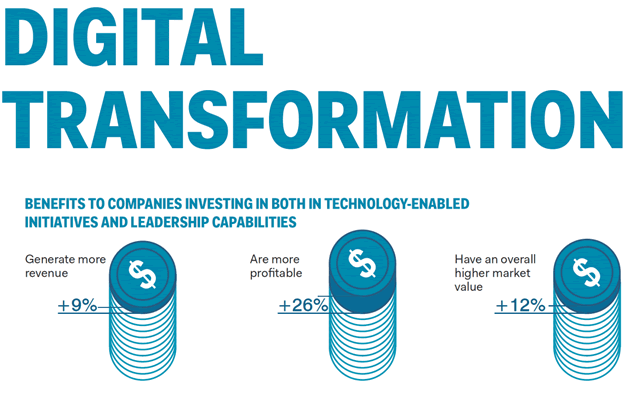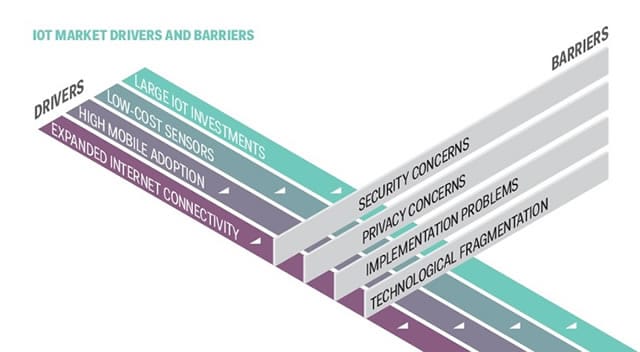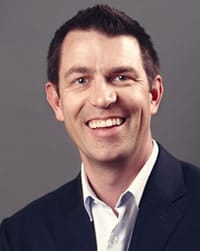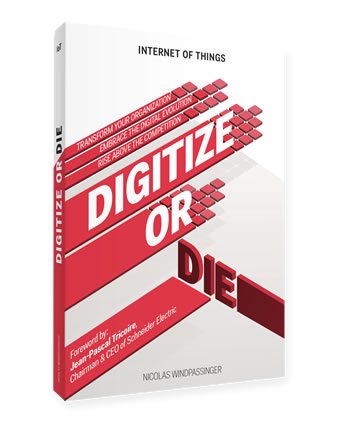There are several books on IoT. However, most IoT books either provide an overview, show a world of possibilities with little actionable strategic information and cases or are purely technical in nature.
We came across the IoT book of Nicolas Windpassinger, global VP of EcoXpert, the partner program of Schneider Electric, which is entitled ‘Digitize or Die’ and were contacted for a preview of the book.
As an engineer, specialized in telecommunications, Nicolas Windpassinger knows the ins and outs of networking and the various technological aspects and components of the Internet of Things.
However, as the VP of Schneider Electric’s EcoXpert Partner Program, he also knows the realities, challenges and evolutions from an IT and OT perspective. Full disclaimer: although we work with Schneider Electric, the book and interview with the author below are not related with this collaboration.
IoT and the (rapidly closing) window of opportunity to take the lead
The EcoXpert channel business partner program, among others, helps and supports companies that have system integration companies to cross the chasm and benefit from new technologies to offer additional services and new revenues to their customers who increasingly seek smart solutions.
Think about electrical contractors, critical power experts, building management system (BMS) engineers (more about building management and IoT) and data center experts who see that the technologies are evolving and need to evolve in order to differentiate themselves in order to be more profitable and grow.
In other words: these are the types of companies where worlds of skillsets have collided in the past (e.g. from mechanical to electrical) and collide and increasingly converge in practice again – and where the real business opportunities of IoT grow exponentially.
By way of an example: according to IDC, the IoT use case that will see the fastest spending growth until 2021 globally is airport facilities automation. It’s something else than what comes to the mind of people when they speak about IoT.
It’s partially from that practical perspective and Nicolas’ experience in ‘the real world’ that IoT book ‘Digitize or Die’ has been written: to be an educational tool, to serve as a guide to digital transformation in an IoT context and a way to fill the digital guide in a hands-on way amidst the IoT revolution which, as Nicolas puts it, is at an inflection point as he explains below.
It’s time that digital transformation leaders grasp the opportunity and are guided through a journey from intent and questions to actions and business value. That’s exactly what ‘Digitize or die’ is about: no hype but a journey whereby author Nicolas Windpassinger doesn’t avoid concerns of executives, while at the same time explaining the Internet of Things from the more technological perspective as well, without being another technology book.
It’s time that digital transformation leaders grasp the IoT opportunity and are guided through a journey from intent and questions to actions and business value.
Moving from IoT questions to IoT-enabled transformation
Nicolas, you are about to publish a book on the Internet of Things in a context of digital transformation. What audience do you have in mind with the book? Business executives, IT managers and CIOs, more technology-oriented readers, others?
Nicolas Windpassinger: ‘Digitize or Die’ is written for the CEOs, CDOs (Chief Digital Officers) and employees of companies that have built a performing analog business and are now asking questions about what the Internet of Things holds in store for their business, regardless whether it is good (opportunities) or bad (risks and challenges, which can be turned into opportunities). ‘Digitize or Die’ addresses these questions and provides the answers.
In particular, the book is intended to be used by senior leaders in manufacturing companies (manufacturing operations is poised to reach an IoT investment of $105 billion), resellers and integrators, software vendors and their related ecosystems. Within these companies, mainly the people who are leading digital transformation such as CDOs, CTOs and CIO/CDIOs will find plenty of guidance in the book.
Focus on IoT strategy: cases and strategies to move from risk to opportunity
You said you focus both on threats and opportunities of IoT in the book but at the same time you want to show how what is perceived as a risk in the end turns out to be an opportunity?
Nicolas Windpassinger: ‘Digitize or Die’ indeed addresses both the threats and the opportunities presented by the Internet of Things.
In the book I balance actual company cases that show how IoT helps in practice and market studies to help leaders form a strategy that gives their companies the tools and methods which are needed to adapt and thrive through their digital transformation journeys.
The book addresses how the IoT will impact current ‘analog’ companies, what strategies organizations can apply to transform a risk into an opportunity and how to focus on specific areas of IoT implications and deployments. However, even these specific examples can help companies discover the possibilities to build a sound transformational strategy by leveraging IoT.
I did a recent blog on Digital Transformation and Financial Performance which shows, based on studies, that digitally mature companies derive more revenue from their physical assets (+9%), are more profitable (+26%) and have overall higher market valuations (+12%). But, digitization can also be the catalyst to failure, as it happened to the well-known examples of companies like Nokia, to name just one.

Addressing the confusion and trepidation around the Internet of Things
You give the infographics of the book away, you have a blog and it seems that the book is part of a broader effort to use all possible means to help companies win with IoT and share your knowledge, born out of a passion for people, technologies, learning and sharing the lessons you and many companies have learned. Why did you write the book to begin with?
Nicolas Windpassinger: As a matter of fact, initially I did not set out to write a book at all. My initial goal was to merely find a book that serves as an overall IoT guide for digital transformation leaders, explaining the why, what and how of IoT with a business and strategy dimension.
To my surprise, there wasn’t one when I looked for it and the idea to write ‘Digitize or Die’ was born. Despite the fact that the Internet of Things is playing such a crucial role in the digital transformation of many organizations all I found were a lot of commercial books and books with a marketing purpose (editor’s note: as mentioned, Nicolas’ book is a personal initiative) but very often with a lack of strategic guidance or only some anecdotal reference to what companies are facing in reality.
None of the technology-oriented IoT books and blogs expanded beyond the pure technology element and addressed the topics that would help companies understand how to transform, leverage IoT themselves and gain strong competitive benefits.
I have witnessed so much confusion and trepidation around the Internet of Things with more questions than answers.
The big purpose of ‘Digitize or Die’ is to explain the new rules of the game and give simple and pragmatic steps to not only survive but succeed with digital transformation, to provide readers with the essential knowledge to understand these new rules.
I have been collaborating with Maxime Zoffoli, a talented professional infographic designer to help the readers of ‘Digitize or Die’ understand complex concepts and information into simple and understandable infographics. We do give away all the infographics of the book for free to all the subscribers to our list.
Why did you decide to call the book ‘Digitize or Die’?
Nicolas Windpassinger: Choosing the title of this book is always one of the most important and challenging tasks—as it was most certainly for me. My dilemma was: how to impart the urgency and the significance of this IoT- and data-driven technological era which is so critical, demanding, and rapidly moving. ‘Digitize or Die’ may sound overly dramatic or cliché, however it is simply the reality.
We see it in all industries where many businesses haven’t finished digitizing processes, especially in the context of IoT. In order to make the difference in digitalization and real digital transformation they need to see that digitizing in the world of connected physical objects as shown in the many cases and examples in the book is essential to shape a smarter environment where different environments are rapidly converging and really disrupt markets with a shift towards the outcomes, insights, actions, improvements and innovations.
The Internet of Things is at its inflection point. The window of opportunity to take advantage of the digital revolution it accelerates, however, is rapidly closing.
IoT disruptions and the window of opportunity
Can you explain more about these disruptions and the window of opportunity of IoT which you explain in the book and have tackled in a blog post?
Nicolas Windpassinger: The Internet of Things is indeed at its inflection point. The window of opportunity to take advantage of the digital revolution it accelerates, however, is rapidly closing.
We see each day that the Internet of Things de facto will disrupt all businesses, including their leaders, and you can take full advantage of this transformation. The question leaders need to ask now is whether they want their company to be a future case study for failure or for success. The choice is entirely up to them.
The IoT is already transforming numerous markets and companies. Making sense of these changes and more importantly, understanding how to leverage them in order to grow head and shoulders above the competition is one of the objectives of the book.

IoT myths: the first movers take it all
On your blog you recently wrote about false IoT beliefs. The myths. Can you elaborate on some?
Nicolas Windpassinger: a myth or false belief with regards to the Internet of Things is that many believe that you need to be the first mover to succeed in any IoT-related business.
For sure, there is this dimension of leaders and laggards which we see popping up each time a game-changing phenomenon starts changing businesses. Yet, the common belief that the first in are always the winners and that to leverage digital transformation and innovation the first is the one that takes it all is a myth.
And this goes for the Internet of Things as well. Bill Gross, IdeaLab’s CEO, conducted research (available on idealab.com) on what made startups successful, using 5 essential elements: ideas, team, business model, funding and timing. The results show that timing is, by 42%, the number one success factor across more than 200 companies.
In transformation and innovation, leveraging the Internet of Things, this dimension of timing is key as well. Indeed, continuous innovation in the IoT market (and others) enables pioneers to defend their market share against new entrants – for some time.
In their research “Pioneer Advantage: Marketing Logic or Marketing Legend“, Peter N. Golder and Gerard J. Tellis, highlight that market pioneers are de facto market leaders upon entry.
However, this leadership does not appear to last very long – 12 years on average before being leap-frogged by later entrants. Their results suggest that “being first in a new market may not confer automatic long-term rewards. An alternative strategy worth considering may be to let other firms pioneer and explore markets, and enter after learning more about the structure and dynamics of the market”.
This doesn’t mean that companies shouldn’t be testing and setting up projects. However, in IoT we typically see a more gradual approach with test projects before more significant and scalable deployments. The winners of the future are not those that go in first but those that go in, in the smartest way. The cases and strategic sections in ‘Digitize or Die’ further illustrator this.
IoT myths: digital natives and incumbents
Nicolas Windpassinger: A second, commonly heard false belief is that, in order to succeed in IoT, you need to be a digital company or a disruptive start-up.
In practice we see that the opposite is often true and, today, the main companies that have deployed IoT strategies with success are incumbents, with a specific focus on industries such as manufacturing, energy, logistics and so forth.
In fact, analog companies have great weapons to fight back potential disrupters and to even lead digital transformation; especially if they leverage their considerable resources such as:
- Investment capitals
- Production capabilities
- Strong brands & demand generation
- Strong channels and ecosystems
- Profound and strong relationships with global accounts
- Sales force on the ground
- Influence power: standardization, market price, specifiers, etc.
When you add the elements of the two myths – time and assets – it’s not too late for incumbents to adapt. They have what is needed to lead and beat competition, leveraging and adapting to the new rules of the game.
On IoT books and lessons learnt
You said that IoT is at its inflection point and that its time for businesses to educate themselves and go strategic now, a significant part of your IoT book. Can you elaborate?
Nicolas Windpassinger: Technologies are evolving laser fast and, as it’s said, accelerating faster than ever, but they have not yet established their “rules of the game”.
What happened to digital cameras in the 1990s and with the Internet at the end of the nineties and beginning of this Millennium is what is happening to IoT right now.
It is indeed an exciting and important time, because you have a unique opportunity to change and adapt the game rules to suit your needs and preferences, and in so doing, outperform your competitors.
That’s why, also in a non-technical way, ‘Digitize or Die’:
- Helps to point out what is going on in the industry,
- helps to transform potential risks into opportunities.
There is a new paradigm that is transforming our economic, social, and political world. It’s going to continue, whether we like it or not. If your company is not already planning to take part in this new world, you might be losing the opportunity to lead the pack in your marketplace.
Three quick final questions as you’re a busy man!
Nicolas Windpassinger: Yes, I would say a passionate man….
- Why should people buy your book?
Nicolas Windpassinger: My commitment to readers is to be their coach, guide them and help them understand what the IoT may hold for them, as well as define a strategy so they can put together an action plan to adapt and succeed.
If readers commit to stay with me throughout the book, I promise them the knowledge to understand what lies behind the fancy acronyms and digital mirage.
If you don’t know the rules of the game, if you don’t spend time learning them, how can you expect to win? If you don’t think about adapting, please certainly forget about succeeding. Your worry is going to be about surviving.
2. What IoT books have you read and did you like yourself?
Nicolas Windpassinger: Epmhasizing the place of IoT in strategy and business, I would advise to read some books that are not necessarily related with IoT. I would highly recommend the following books each one for different reasons:
- The World Economic Forum White Paper, Digital transformation of industries. 2016. For its vision and clarity on possible strategies (PDF opens).
- Alan Lewis and Dan McKone, Edge Strategy: A new mindset for profitable growth. s.l. : Harvard Business Review. For its methodology that makes the link between a strategy and the execution of it. Their approach really applies very well to the IoT and to digital transformation
- Grant, Adam. Originals: How Non-conformists Change the World. s.l. : WH Allen, 2016. For the work being done that highlights the role of individuals in the transformation and digitization of a business and their importance on execution.
3. What has the process of writing an IoT book taught you about the IoT itself, about writing or about anything else that struck you?
Nicolas Windpassinger: Writing the book really made me realize that we are in a unique time window, we are at the crossroads where, until now, IoT was mainly used as a buzzword to the reality of IoT as a relevant and proven business enabler.
IoT is only another milestone into the digitization of our society and the ways in which we live and do business… but a passionate milestone. It is what the Internet has been to information: the accelerator.



